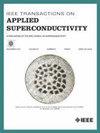高亮度LHC升级用束分离偶极磁体生产现状
IF 1.7
3区 物理与天体物理
Q3 ENGINEERING, ELECTRICAL & ELECTRONIC
引用次数: 0
摘要
高亮度大型强子对撞机升级(HL-LHC)的两个相互作用点(ATLAS和CMS)两侧将安装束分离偶极体(D1磁体,MBXF)。高能加速器研究组织(KEK)负责为HL-LHC项目提供一个全尺寸原型机和六个系列生产冷质量。从KEK公司转移技术后,日立公司已经建成了三个系列生产磁体(MBXF1、5、2,按试验顺序)和原型冷体(LMBXFP1)。在KEK进行了系列生产磁体的冷动力试验。淬火电流达到峰值磁场对应的极限电流为6.0 T,负载线比为83%。MBXF1和2经历了完整的热循环和良好的训练记忆。磁场测量结果表明,三个系列生产磁体的积分多极系数是可重复的,并且从模拟中得到了预期的控制。在欧洲核子研究中心进行了LMBXFP1在大型强子对撞机低温恒温器上的水平冷动力试验。测量的多极系数与计算结果一致,表明考虑铁磁低温恒温器影响的磁设计是有效的。本文章由计算机程序翻译,如有差异,请以英文原文为准。
Status of Production of Beam Separation Dipole Magnets for the High-Luminosity LHC Upgrade
Beam separation dipole magnets (D1 magnet, MBXF) will be installed on both sides of two interaction points (ATLAS and CMS) for the High-Luminosity Large Hadron Collider upgrade (HL-LHC). High Energy Accelerator Research Organization (KEK) is responsible for delivering one full-scale prototype and six series production cold masses to the HL-LHC project. Three series production magnets (MBXF1, 5, and 2, in order of testing) and the prototype cold mass (LMBXFP1) have been constructed by Hitachi, Ltd. after technological transfer from KEK. Cold powering tests of the series production magnets were conducted at KEK. The quench current reached the ultimate current corresponding to the peak field of 6.0 T and the load line ratio of 83% . MBXF1 and 2 experienced a full thermal cycle and good training memory was confirmed. The results of magnetic field measurements show that the integrated multipole coefficients are reproducible among three series production magnets and controlled as expected from the simulations. A horizontal cold powering test of LMBXFP1 with an LHC cryostat was performed at CERN. Measured multipole coefficients were consistent with the calculation results, suggesting the validity of the magnetic design considering the effect of the ferromagnetic cryostat.
求助全文
通过发布文献求助,成功后即可免费获取论文全文。
去求助
来源期刊

IEEE Transactions on Applied Superconductivity
工程技术-工程:电子与电气
CiteScore
3.50
自引率
33.30%
发文量
650
审稿时长
2.3 months
期刊介绍:
IEEE Transactions on Applied Superconductivity (TAS) contains articles on the applications of superconductivity and other relevant technology. Electronic applications include analog and digital circuits employing thin films and active devices such as Josephson junctions. Large scale applications include magnets for power applications such as motors and generators, for magnetic resonance, for accelerators, and cable applications such as power transmission.
 求助内容:
求助内容: 应助结果提醒方式:
应助结果提醒方式:


